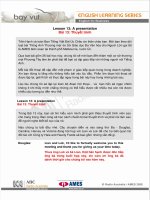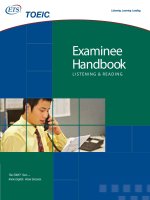Tài liệu K-12 World Languages Curriculum ppt
Bạn đang xem bản rút gọn của tài liệu. Xem và tải ngay bản đầy đủ của tài liệu tại đây (368.5 KB, 39 trang )
South Burlington School District
K-12 World Languages Curriculum
Local Guidelines
for Standards-Based Curriculum
Implementation
Adopted by the Board of School Directors February 9, 2000
E:\Steve\Professional\Curriculum\WorldLang\Teacher List.doc
WORLD LANGUAGES COMMITTEE
High School
Tim Kahn
Karen Couillard
Lori Dow-Moore
Martina Lemm
Robert Schermer
Ann Sorrell
Maritza Valencia
Ben Clarke
Heidi Western
Beth Echert
Middle School
Barbara Gill
Beth Martel
Barbara Robitaille
Central Elementary School
Zonia Davila-Desranleau
Chamberlin Elementary School
Magali Simon-Martin
Orchard Elementary School
Mary Tetreault
1/00
District Mission Statement
The mission of the South Burlington School District, a community committed to excellence in
education, is to ensure that each student possesses the knowledge, skills, and character to create a
successful and responsible life. We will do this by building safe, caring, and challenging learning
environments, fostering family and community partnerships, utilizing global resources, and
inspiring life-long learning.
Table of Contents
Page
K-12 Philosophy ..........................................................................................................1
K-12 World Language Standards.................................................................................3
Learning Opportunities ................................................................................................9
Elementary
K-2 .............................................................................................................................13
3-5 ..............................................................................................................................15
Middle School
French 6 .....................................................................................................................17
French 7 .....................................................................................................................19
French 8 .....................................................................................................................21
Spanish 6....................................................................................................................23
Spanish 7....................................................................................................................25
Spanish 8....................................................................................................................27
High School
French 1A...................................................................................................................29
French 1B...................................................................................................................31
French 2 .....................................................................................................................33
French 3 .....................................................................................................................35
French Pre-AP............................................................................................................37
French AP ..................................................................................................................39
German 1....................................................................................................................41
German 2....................................................................................................................43
German 3....................................................................................................................45
German 4....................................................................................................................47
Spanish 1A.................................................................................................................49
Spanish 1B .................................................................................................................51
Spanish 2....................................................................................................................53
Spanish 3....................................................................................................................55
Spanish 4....................................................................................................................59
Advanced Placement Spanish....................................................................................61
Latin 1 and 2 ..............................................................................................................63
Japanese 1 ..................................................................................................................65
Assessment.................................................................................................................67
Appendix..................................................................................................................105
South Burlington School District
K-12 WORLD LANGUAGES PHILOSOPHY
We believe:
1. that experience with and in a second language is intellectually beneficial to all American students.
2. that the study of a second language enables students to acquire an understanding of the nature of
language and human communications.
3. that the student’s command of English vocabulary and structure will be enriched by the study of a
second language, especially one related to English.
4. that by learning to express themselves in another language, even if only in a rudimentary fashion,
students become more appreciative and more tolerant of the communication efforts of those for whom
English is a second language.
5. that the study of a second language and its corresponding cultures makes American students more
aware of the ideas, activates, and attitudes of the non-English speaking world.
6. that in our pluralistic world society, the ability to communicate in a second language will broaden
students’ career opportunities.
7. that in a period of expanding leisure time both during one’s productive years and at retirement, the
ability to use a second language increases opportunities for personal fulfillment at home and in
society.
8. that second language learning is most effective when begun at an early age and most lasting when the
product of a long sequence of guided study.
9. that second language skills are best maintained through repeated informal contacts with language via
media, reading, travel, and personal contact.
Adopted by the K-12 World Language Department
from the North East Conference Credo
MODIFIED LATIN STANDARDS
COMMUNICATION STANDARDS
Communicate in a Classical Language
1.1 Students should be able to read, understand, and interpret Latin.
1.2 Students should be able to use orally, listen to, and write Latin as part of the language learning
process.
CULTURE
Gain Knowledge and Understanding of Greco-Roman Culture
2.1 Students should be able to demonstrate an understanding of the perspectives of Roman culture as
revealed in the practices of the Greeks or Romans.
2.2 Students should be able to demonstrate an understanding of the perspectives of Roman culture as
revealed in the products of the Romans.
CONNECTIONS
Connect with Other Disciplines and Expand Knowledge
3.1 Students should be able to reinforce and further their knowledge of other disciplines through their
study of Latin.
3.2 Students should be able to expand their knowledge through the reading of Latin and the study of
ancient culture.
COMPARISONS
Develop Insight into Own Language and Culture
4.1 Students should be able to recognize and use elements of the Latin language to increase knowledge of
their own language.
4.2 Students should be able to compare and contrast their own culture with that of the ancient Roman
world.
COMMUNITIES
Participate in Wider Communities of Language and Culture
5.1 Students should be able to use their knowledge of Latin in a multilingual world.
5.2 Students should be able to use their knowledge of ancient Roman culture in a world of diverse
cultures.
LEARNING OPPORTUNITIES
Learning Opportunities are recommended practices to support all students in attaining the VT standards
A. ACCESS
Content
1. Access to rigorous content, knowledge and skills described in the VT Framework.
Instructors
2. Access to instructors who are knowledgeable about the disciplines they teach, about the
developmental characteristics of the students they teach, and about best practices in teaching
and learning.
Resources
3. Access to accurate information, materials and current resources
(in addition to textbooks) that are
appropriate for the learning goals.
Time
4. Instruction that uses time effectively and flexibly to achieve learning goals.
Safe and Healthy Environment
5. A physically and emotionally safe, educationally supportive environment in which to learn.
B. INSTRUCTION
Acquiring Knowledge and Skills
1. Learning experiences that engage students in active learning, build on prior knowledge and
experiences, and develop conceptual and procedural understanding, along with student
independence.
Variety of Instructor Roles
2. Teachers who use a variety of teaching roles (e.g., direct instruction, facilitating, modeling,
coaching, reflecting, and guiding observing), and adapt these as appropriate for different purposes
of instruction and student needs.
Multiple Student Roles
3. Opportunities to learn through a variety of roles (e.g., planner, questioner, artist, scientist,
historian), alone and with others.
Application and Reflection
4. Projects and assignments that require students to integrate and apply their learning in meaningful
contexts, and to reflect on what they have learned.
Adaptive Learning Environments
5. Learning environments that are adapted so that all students achieve success.
C. ASSESSMENT AND REPORTING
Multiple Assessment Strategies
1. A balance and variety of assessment strategies used to gain information and provide feedback
about student learning (e.g., performance assessments, self-assessments, paper-and-pencil tests,
checklists, etc.).
Criteria
2. Expectations and performance criteria are clear and public.
Use of Assessment to Inform Instruction and Guide Student Learning
3. Assessment results that are used to influence instructional decisions and to plan the next learning
steps for students.
Self-Assessment
4. Students use clear criteria and examples to evaluate their own work.
Effective Communication of Assessment Information
5. Classroom-based assessments that are combined with other measures to communicate information
about student learning.
D. CONNECTIONS
Interdisciplinary Connections
1. Learning experiences that illustrate strong connections within and across the fields of knowledge.
Relevance
2. Learning experiences that have personal, community, and/or global relevance.
Family and Community Collaboration
3. An educational climate that is collaborative, in which school staff, families, health and human
services personnel, and community members work together to support all learners.
WORLD LANGUAGES LEARNING EXPECTATIONS
GRADES K-2
K-2 languages meet for 20 to 30 minutes per week. The focus is on oral language and
Cultures of the French or Spanish-speaking peoples. Choral and individual drills develop proper
pronunciation and ease with the sounds of the language. Lessons and activities stress vocabulary and
listening comprehension.
By the end of kindergarten all students should be able to:
1. use common classroom expressions.
2. identify limited classroom objects.
3. recognize and name the primary colors.
4. understand basic commands in the target language.
5. greet and say farewell to people.
6. count to 20.
7. recite, sing and/or name the days of the week.
8. recognize, sing and/or recite the letters of the alphabet.
9. participate in cultural activities including games, songs, stories and celebrations.
By the end of first grade all students should be able to:
1. Use common classroom expressions.
2. follow simple instructions and commands in the target language.
3. recite, sing and/or name the months of the year.
4. explore a variety of expressive forms from the target culture including art music, dance,
song and literature.
5. recognize words that are borrowed from one language to another (cognates).
6. use appropriate vocabulary and oral expressions for greetings, saying their name and
farewells.
7. express likes and dislikes using specific topics.
8. count to 40.
By the end of second grade all students should be able to:
1. use common classroom expressions.
2. express simple feelings.
3. identify people: titles and family.
4. understand and use courtesy phrases.
5. count to 60 and do simple arithmetic.
6. recite, pronounce and sing with rhythm and expression.
7. present basic biographical information about self: name, age, birthday.
8. distinguish between sound patterns of the target language and their native language.
9. express simple weather terms.
10.
identify farm animals and pets.
WORLD LANGUAGES LEARNING EXPECTATIONS
GRADES 3-5
Grades 3-5 meet for forty-sixty minutes per week. The emphasis is on spoken language and the
introduction of written work with vocabulary and listening continuing to be key elements. Reading
the language is introduced in fourth grade as well as the study of elementary grammar concepts. The
materials used in instruction are mostly teacher-created along with stories, songs, poetry, and audio-
visual materials.
By the end of third grade students should be able to:
1. use common classroom expressions.
2. expand their vocabulary to express likes and dislikes, feelings and favorite sports and
activities.
3. count to 100 and do simple arithmetic.
4. understand and demonstrate useful classroom phrases, request permission for various needs.
5. identify and describe self (parts of the body).
6. ask and tell time (whole hour only).
7. identify zoo animals.
8. follow simple oral and written instructions .
9. distinguish between the writing system of the target language and their native language.
10. identify parts of the world where target language is spoken.
By the end of fourth grade all students should be able to:
1. use common classroom expressions.
2. express likes and dislikes, feelings, needs and simple preferences.
3. ask and express time after and before the hour.
4. identify and describe immediate family members.
5. identify people, places and things based on oral and written descriptions.
6. introduce peer or adult.
7. perform short dialogues or stories.
8. make comparisons between the celebrations, food, housing and clothing of the target culture
and their native culture.
9. count to 300 and do simple arithmetic.
10. ask simple questions.
11. understand the concept of verb conjugation.
By the end of fifth grade all students should be able to:
1. use common classroom expressions.
2. express likes, dislikes, feelings, needs and simple preferences.
3. recite oral stories, songs, poems or proverbs.
4. give and follow simple instructions and/or commands .
5. use appropriate vocabulary and oral expressions for greetings, introductions, saying name,
age, address, phone number, place of origin and state of being.
6. demonstrate comprehension of short written messages.
7. introduce peers and adults (formal and informal “you”).
8. identify rooms and write a short description of a house, using prepositions and the verb to be.
9. create poems to share with others.
10. acquire knowledge about people in both their native culture and the target culture relating to
family, school, work and play.
11. describe people, courses at school, home and pets.
12. count to 500 and do simple arithmetic.
FOREIGN LANGUAGES LEARNING EXPECTATIONS
FRENCH 6
French 6 at the middle school is a two-semester course, which meets twenty minutes daily. This
course emphasizes seven language skills: Speaking, listening, reading, writing, culture, grammar,
and vocabulary acquisition. The primary focus is on students’ learning to understand and to speak
with native speakers of French and to read and write using basic constructions. Materials used
include the core text, teacher-generated materials, videos, audiocassettes, and computer programs.
Research on the Internet and communication with our partner school in Perigueux, France via e-mail
are additional resources.
By the end of this course all students should be able to:
1. use common classroom expressions in French.
2. greet and say farewell.
3. introduce self and others, to ask one’s name.
4. ask basic questions.
5. inquire and give information about a person’s well being.
6. use levels of formality appropriately.
7. state and inquire where a person lives.
8. state and inquire how old a person is.
9. describe a classroom and courses.
10. name, locate and ask about objects in a classroom.
11. use and understand simple classroom requests and commands, say that someone is early
or late.
12. pronounce the French alphabet correctly.
13. spell a word using the French alphabet.
14. identify words from dictation using the French alphabet.
15. count from 0 to 60.
16. spell the numbers from 0 to 60.
17. perform simple arithmetic.
18. use numbers to respond to and ask questions pertaining to date, age, price, and
quantities.
19. identify numbers from dictation of phone numbers, and the date.
20. say what the date is using days of the week, months and date in the correct order.
21. spell the days, months and date.
22. identify birthdays and holidays.
23. tell what time it is.
24. inquire and tell when an activity takes place.
25. talk about the seasons and weather.
26. inquire and tell in what season and weather activities take place.
27. write about season and weather and activities spelling correctly and describing
where and with whom using correct grammar.
28. talk about activities.
29. describe likes and dislikes using double verb construction and negative.
30. inquire about others’ likes and dislikes using question words.
31. describe nationality and appearance of self and others.
32. give a detailed description of appearance, occupation, likes and dislikes, and favorite
activities of a person using adverbs.
33. describe family members, their appearance, likes and dislikes, discuss possession.
34. make travel arrangements.
35. purchase a plant/train ticket.
36. inquire about arrival/departure schedules.
37. deal with customs/immigration.
38. make arrangements for an accommodation.
39. discuss public transportation.
40. inquire about and give directions to where a person or place is located.
41. exchange money and travelers’ checks.
42. inquire about public transport.
43. report on French-speaking countries.
44. discuss simple geographical, economical, and political data of a French-speaking country.
WORLD LANGUAGES LEARNING EXPECTATIONS
FRENCH 7
French 7 at the middle school is a two-semester course, which meets forty-two minutes every other
day. It emphasizes seven language skills: Speaking, listening, reading, writing, culture, grammar,
and vocabulary acquisition. The primary focus is on students’ learning to understand and to speak
with native speakers of French, and to read and write using basic constructions. Materials used
include the core text, teacher-generated materials, videos, audiocassettes, and computer programs.
Research on the Internet and communication with our partner school in Périgueux, France via e-mail
are additional resources.
By the end of this course all students should be able to:
1. use common classroom expressions in French.
2. say where a person is going using place names.
3. express what is going to happen using the immediate future tense.
4. state nationality of self and others.
5. give a detailed description of appearance, occupation, likes and dislikes.
6. describe favorite activities of a person using adverbs.
7. describe family members, their appearance, personality, likes and dislikes.
8. discuss ownership and possession.
9. plan a trip.
10. make travel arrangements.
11. specify travel preferences.
12. purchase a plane/train/bus ticket.
13. inquire and give information about arrival/departure schedules.
14. deal with customs/immigration.
15. make arrangements for an accommodation.
16. inquire about and give directions to where a person or place is located.
17. exchange money and travelers’ checks.
18. inquire about public transportation.
19. identify French-speaking countries in the World and their capitals.
20. discuss simple geographical, economical, and political data of a French-speaking country.
21. use more sophisticated commands, suggestions, and requests.
22. count from 60-1,000.
23. spell the numbers from 60 to 1,000.
WORLD LANGUAGES LEARNING EXPECTATIONS
FRENCH 8
French 8 at the middle school and French 1B at the high school emphasizes seven language skills:
Speaking, listening, reading, writing, culture, grammar, and vocabulary acquisition. The primary
focus is on students’ learning to understand and to speak with native speakers of French, and to read
and write using basic constructions. Materials used include the core text, teacher-generated
materials, videos, audiocassettes, and computer programs. Research on the Internet and
communication with our partner school in Périgueux, France via e-mail are additional resources.
By the end of this course all students should be able to:
1. use common classroom expressions in French.
2. discuss a regular school day reviewing time, days of the week, and months.
3. compare and contrast education, schedules, courses, grading, levels and expectations of
French and American educational systems.
4. expand classroom expressions, inquire and respond to instruction delivered totally in
French.
5. make and inquire about plans for the weekend and vacation; sports, hobbies, travel,
culture.
6. name foods items and categories.
7. use quantities and convert American standards units to the Metric system.
8. inquire about, request and purchase food at the appropriate store or market.
9. bargain with a vendor using French monetary system.
10. plan a meal, choose recipes and ingredients.
11. discuss varying eating habits and customs including table setting.
12. discuss and inquire about food preferences.
13. make a reservation at a restaurant.
14. order food; make requests including clarification of ingredients and necessary utensils.
15. complain or praise.
16. request, discuss and pay the bill.
17. describe an item of clothing.
18. be able to convert to European size.
19. describe what a person is wearing.
20. discuss fashion.
21. shop for clothes discussing size and style with a salesperson.
22. describe physical characteristics and well being.
23. make an appointment at a doctor’s office and talk about health issues with a health
professional.
24. identify rooms and furniture in a house and say where they are located.
WORLD LANGUAGES LEARNING EXPECTATIONS
SPANISH 6
Spanish 6 introduces the student to the language and culture of the Spanish-speaking world. It is a
20-minute class that meets every day. A high level of student participation is achieved through the
use of materials and activities designed to enable the student to use the language correctly for
communication and basic skills of listening, comprehension, reading and writing are also stressed.
Special emphasis is placed on studies of the Hispanic culture in the United States.
By the end of this course, all students should be able to:
1. use common classroom expressions in Spanish.
2. introduce oneself.
3. greet someone.
4. ask and tell where one is from.
5. identify yourself and spell your name.
6. learn names of countries in the Spanish-speaking world.
7. learn some classroom expressions and identify classroom objects.
8. ask for and tell the date and time.
9. count to 100 and do simple arithmetic.
10. ask about and express quantity: how much and how many.
11. find out when something occurs.
12. ask for and give phone numbers.
13. express likes and dislikes (sports, leisure, food, school and home activities).
14. express agreement and disagreement.
15. ask and explain “why?”; ask “who?”.
16. describe people and things; identify family members.
17. shop for clothing and ask how much it costs.
WORLD LANGUAGES LEARNING EXPECTATIONS
SPANISH 7
Spanish 7 is a continuation of Spanish 6. It continues to introduce the student to the language and
culture of the Spanish-speaking world. It meets for 40 minutes every other day. A high level of
student participation is achieved through the use of materials and activities designed to enable the
student to use the language correctly for communication and basic skills of listening,
comprehension, reading and writing are also stressed. Special emphasis is placed on studies of the
Hispanic culture in the United States.
By the end of this course, all students should be able to:
1. use common classroom expressions in Spanish.
2. describe people and things; identify family members.
3. shop for clothing and ask how much it costs.
4. distinguish colors and express preferences.
5. ask about and describe weather.
6. express what you and others are doing.
7. request information by asking questions.
8. say no, explain why not, and contradict.
9. ask and tell where someone is going and how they are going (car, bus, plane, etc.).
10. ask for and give an address.
11. ask and tell where something is or where people are.
12. give and understand directions.
13. conduct a simple phone conversation.
14. identify ownership.
15. describe how people are feeling.









